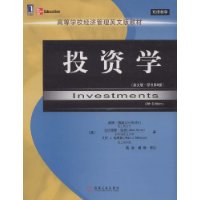本书详细讲解了投资领域中的风险组合理论、资本资产定价模型、套利定价理论、市场有效性、证券评估、衍生证券、资产组合管理等重要内容,观点权威,阐述详尽,结构清楚,设计独特,语言生动活泼,学生易于理解,内容上注重理论与实践的结合。
本书适用于:金融专业高年级本科生、研究生及MBA、金融领域研究人员、从业者。
插图:

Options
A call option gives its holder the right to purchase an asset for a specified price, called the exercise or strike price, on or before a specified expiration date. For example, a December call option on General Electric stock with an exercise price of $35 entitles its owner to purchase GE stock for a price of $35 at any time up to and including the expiration date in December. Each option contract is for the purchase of 100 shares. However, quotations are made on a per-share basis. The holder of the call need not exercise the option; it will be profitable to exercise only if the market value of the asset that may be purchased exceeds the exercise price.
When the market price exceeds the exercise price, the option holder may "call away" the asset for the exercise price and reap a payoff equal to the difference between the stock price and the exercise price. Otherwise, the option will be left unexercised. If not exercised before the expiration date of the contract, the option simply expires and no longer has value. Calls therefore provide greater profits when stock prices increase and thus represent bullish investment vehicles.
In contrast, a put option gives its holder the right to sell an asset for a specified exercise price on or before a specified expiration date. A December put on GE with an exercise price of $35 thus entitles its owner to sell GE stock to the put writer at a price of $35 at any time before expiration in December, even if the market price of GE is lower than $35. Whereas profits on call options increase when the asset increases in value, profits on put options increase when the asset value falls. The put is exercised only if its holder can deliver an asset worth less than the exercise price in return for the exercise price.
Figure 2.10 presents options quotations for GE. The price of GE shares on this date was $41.10. The first two columns give the expiration month and exercise (or strike) price for each option. We have included listings for call and put options with exercise prices ranging from $37.50 to $42.50 per share, and with expiration dates in October, November, December 2007 and March 2008.

